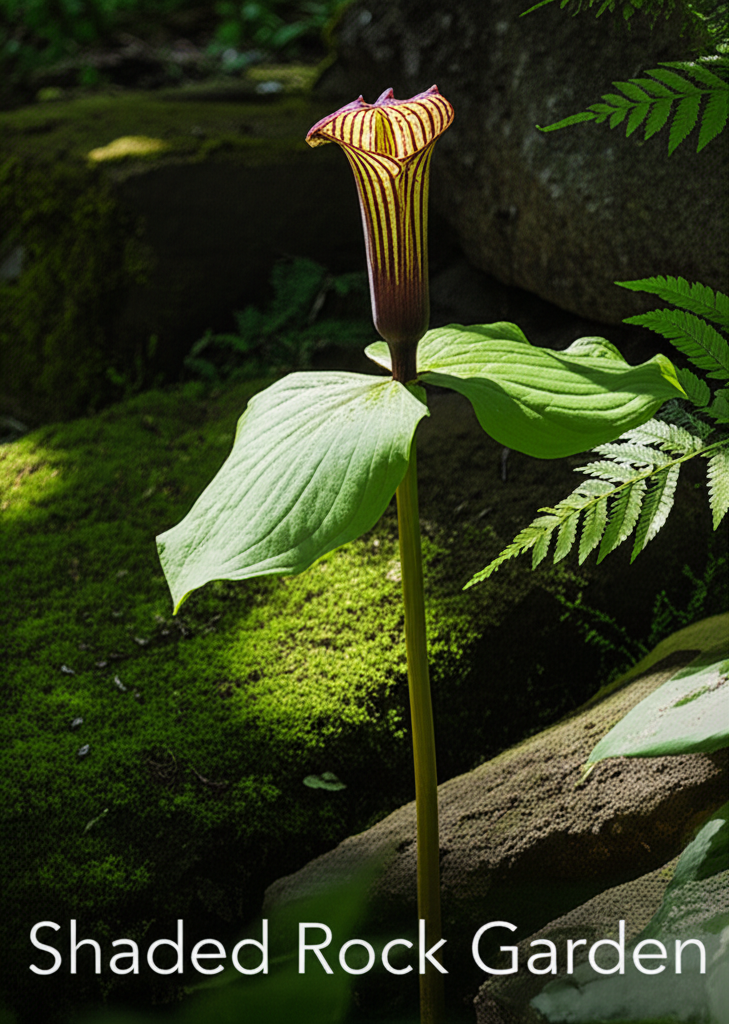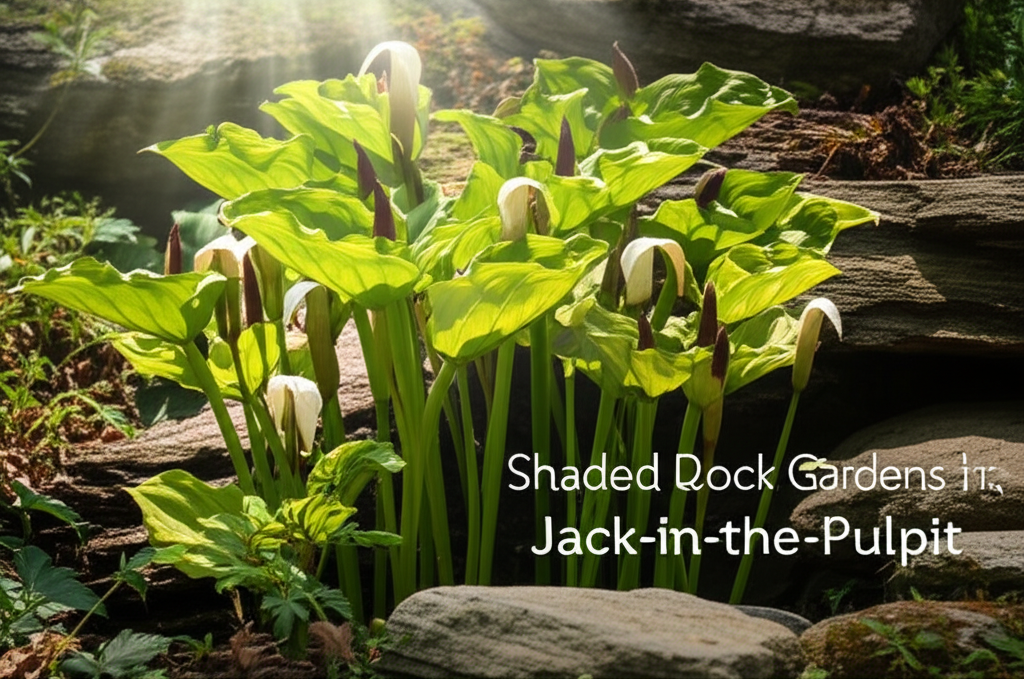Introduction to Jack-in-the-Pulpit
The Jack-in-the-Pulpit, scientifically known as Arisaema triphyllum, is a captivating woodland wildflower native to eastern North America. Its unique and striking appearance, resembling a pulpit with a preacher within, has earned it a place of honor in many native plant gardens. While often associated with damp, wooded areas, its resilience and adaptability make it an excellent candidate for shaded rock garden designs, offering a touch of the wild and botanical intrigue to these often structured environments. This article will explore why Jack-in-the-Pulpit thrives in such settings, how to incorporate it successfully, and the benefits it brings to a shaded rock garden.
Understanding Jack-in-the-Pulpit’s Botanical Appeal

The allure of the Jack-in-the-Pulpit lies in its distinctive floral structure. The plant features a spathe (the hooded sheath) and a spadix (the finger-like projection within). The spathe, often striped with green, purple, or brown, arches over the spadix, creating the iconic “Jack” figure. This intricate design is not merely ornamental; it serves a biological purpose, guiding small insects into the spathe to pollinate the tiny flowers clustered at the base of the spadix.
Beyond its flower, the plant boasts attractive trifoliate leaves, typically composed of three leaflets. In late summer and autumn, these leaves give way to vibrant clusters of red berries, adding another layer of visual interest and providing a food source for local wildlife.
Why Jack-in-the-Pulpit is Ideal for Shaded Rock Gardens
Shaded rock gardens, by their nature, mimic the dappled light and rocky outcrops found in woodland environments. This makes them a surprisingly perfect habitat for Jack-in-the-Pulpit, which naturally prefers conditions found in its native woodland habitat.
Key Environmental Preferences of Jack-in-the-Pulpit
- Shade Tolerance: Jack-in-the-Pulpit thrives in partial to full shade. Direct, harsh sunlight can scorch its leaves and dry out the soil, conditions rarely found in its natural, shaded forest floor environment. A north-facing or east-facing aspect, or areas beneath deciduous trees, are ideal.
- Moisture Retention: While not waterlogged, Jack-in-the-Pulpit prefers consistently moist soil. The rocky structure of a rock garden can sometimes lead to rapid drainage. However, careful selection of planting locations within the garden, particularly in depressions or areas where organic matter has accumulated, can ensure adequate moisture. Companion planting with other shade-loving, moisture-retentive plants can also help create a microclimate.
- Soil Composition: Rich, humus-rich soil is paramount. This can be achieved in a rock garden by amending the soil with ample compost, leaf mold, and well-rotted manure. The porous nature of rocks can also aid aeration, which is beneficial.
- Nutrient Content: As a woodland plant, it benefits from nutrient-rich soil, mimicking the decaying organic matter found on forest floors.
Complementary Aesthetics in a Shaded Rock Garden
The organic, somewhat wild form of Jack-in-the-Pulpit contrasts beautifully with the more structured elements often found in rock gardens. Its unique bloom adds a sculptural element, while its lush foliage provides a soft counterpoint to the angularity of stones. When placed strategically amongst ferns, hostas, heucheras, and other shade-loving perennials, it creates a harmonious, naturalistic display.
Designing Your Shaded Rock Garden with Jack-in-the-Pulpit
Successfully integrating Jack-in-the-Pulpit into a shaded rock garden requires thoughtful planning and consideration of its specific needs.
Site Selection and Preparation
- Location: Identify areas within your rock garden that receive consistent shade throughout the day, especially during the hottest afternoon hours. Dappled shade beneath deciduous trees is particularly ideal, as it provides seasonal light changes that the plant can tolerate.
- Soil Amendment: Before planting, generously amend the chosen spots with organic matter. A mix of compost, leaf mold, and a small amount of coarse sand or perlite can improve drainage while retaining moisture and providing essential nutrients. Aim for a soil pH that is slightly acidic to neutral.
- Drainage Considerations: While Jack-in-the-Pulpit likes moisture, it dislikes sitting in waterlogged soil, which can lead to corm rot. Ensure that the planting pockets have adequate drainage. If your rock garden tends to retain too much water, consider incorporating more grit or perlite into the soil mix in those specific areas.
Planting Techniques
- Depth: Jack-in-the-Pulpit grows from a corm (a swollen underground stem). Plant the corms about 4-6 inches deep, with the pointed end facing upwards. This depth helps protect the corm from drying out and provides stability.
- Spacing: Allow ample space for the plant to grow. Mature plants can reach a height of 1-3 feet. Planting them at least 12-18 inches apart will prevent overcrowding and ensure good air circulation.
- Companion Planting: Choose companions that share similar environmental needs. Excellent choices include:
Ferns: Lady Fern (Athyrium filix-femina), Christmas Fern (Polystichum acrostichoides), Ostrich Fern (Matteuccia struthiopteris).
Groundcovers: Wild Ginger (Asarum canadense), Creeping Jenny (Lysimachia nummularia), Foamflower (Tiarella cordifolia).
Other Perennials: Hosta varieties, Heuchera (Coral Bells), Astilbe, Bleeding Hearts (Dicentra spectabilis).
- Placement within the Rock Garden: Position Jack-in-the-Pulpit in the foreground or mid-ground of your rock garden, where its unique form can be easily appreciated. It can be nestled amongst larger rocks or planted in clusters for greater visual impact. Avoid planting it in direct competition with aggressive spreaders.
Seasonal Interest and Care
Jack-in-the-Pulpit offers a fascinating cycle of seasonal interest that enhances any garden design.
Spring Bloom and Foliage
In early to mid-spring, the characteristic spathe and spadix emerge, often before the leaves fully unfurl. This provides an early-season spectacle. As the weather warms, the trifoliate leaves develop, creating lush green foliage that fills out the garden space.
Summer and Autumn Transformation
During the summer, the plant matures, and its foliage remains attractive. In late summer and autumn, the leaves begin to yellow and die back, revealing the developing cluster of bright red berries. This transition adds a splash of vibrant color to the garden as other plants may be fading.
Winter Dormancy
Jack-in-the-Pulpit is a perennial that goes dormant in winter. Its corm lies safely underground, storing energy for the following spring. The dying foliage and berries should ideally be left in place until spring to provide food and habitat for wildlife and to protect the soil.
Watering and Fertilizing
- Watering: Maintain consistent moisture, especially during dry spells. Water deeply at the base of the plant to encourage strong root development. Overwatering should be avoided.
- Fertilizing: Jack-in-the-Pulpit is not a heavy feeder. A top-dressing of compost or well-rotted manure in early spring is usually sufficient. Avoid high-nitrogen fertilizers, which can promote excessive leafy growth at the expense of flowering.
Pest and Disease Management
Jack-in-the-Pulpit is generally quite resilient. However, occasional issues can arise:
- Slugs and Snails: These common garden pests can sometimes nibble on the leaves. Employ organic methods like beer traps or copper tape to deter them.
- Corm Rot: This is usually caused by poor drainage and overwatering. Ensuring the planting site is well-drained is the best preventative measure.
Key Facts and Comparison with Other Woodland Plants
When considering Jack-in-the-Pulpit for your shaded rock garden, it’s helpful to compare its characteristics with other popular woodland plants.
| Feature | Jack-in-the-Pulpit (Arisaema triphyllum*) | Hostas | Ferns | Heuchera (Coral Bells) |
|---|---|---|---|---|
| Bloom Time | Spring (April-June) | Summer (June-August) | Foliage is primary interest; some have small, inconspicuous flowers. | Late spring to summer (June-August) |
| Flower Appearance | Unique spathe and spadix | Bell-shaped, often in spikes | Variable; some produce spores on undersides of leaves. | Small, bell-shaped flowers on tall scapes |
| Foliage | Trifoliate, lush green | Broad, varied colors and textures | Feathery, delicate to robust | Lobed, colorful, often evergreen or semi-evergreen |
| Light Requirements | Partial to full shade | Partial to full shade (some tolerate more sun) | Partial to full shade | Partial shade to full shade (color is best with some light) |
| Moisture Needs | Consistently moist, well-drained soil | Moist, well-drained soil | Moist, well-drained soil | Moist, well-drained soil |
| Soil pH | Slightly acidic to neutral | Neutral to slightly acidic | Slightly acidic to neutral | Neutral to slightly acidic |
| Unique Feature | “Jack” flower formation, red berries | Vast diversity in size, color, and texture | Architectural form, spore production | Striking leaf colors |
Steps, Pros, and Cons of Using Jack-in-the-Pulpit in Rock Gardens
Incorporating any plant into a garden design involves weighing its benefits against potential challenges.
| Aspect | Details |
|---|---|
| Steps to Success |
|
| Pros |
|
| Cons |
|
Cultivating a Thriving Ecosystem
Beyond its visual appeal, Jack-in-the-Pulpit plays a vital role in the miniature ecosystem of your shaded rock garden.
Attracting Pollinators and Wildlife
The unique flower structure is designed to attract small insects like gnats and thrips, which become trapped inside, facilitating pollination. The vibrant red berries produced in the fall are a valuable food source for birds and other small mammals, helping them prepare for winter. By incorporating native plants like Jack-in-the-Pulpit, you are contributing to biodiversity and providing essential resources for local fauna.
Enhancing Soil Health
The decaying foliage and organic matter from Jack-in-the-Pulpit and its companions contribute to the ongoing enrichment of the soil in your rock garden. This organic material improves soil structure, water retention, and nutrient availability, creating a healthier environment for all the plants within the garden.
Conclusion
Jack-in-the-Pulpit is a truly remarkable plant that offers a unique blend of botanical intrigue and ecological value. Its adaptability to the shaded, moist conditions found in rock gardens, coupled with its striking appearance and contribution to local wildlife, makes it an exceptional choice for discerning gardeners. By understanding its needs and incorporating it thoughtfully into your shaded rock garden design, you can create a dynamic, visually captivating, and ecologically beneficial landscape. The “Jack” in your garden’s “pulpit” will undoubtedly be a conversation starter and a source of endless fascination.


